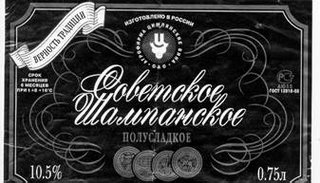Aristocratic Champagne
Russian champagne production goes back a long way, with the first winery established back in 1799 to serve the Tsarist aristocracy. However, this first attempt failed, and only in 1891 was the first successful winery established at Abrau-Durso (in present-day Ukraine) by Prince Lev Golitsyn. Demand boomed almost immediately and at the Paris World Fair in 1900, Golitsyn's Novy Svet won the Grand Prix for champagne, bringing recognition abroad.
Revolutionary Champagne
But this association with the elite almost led to the destruction of the fledgling industry, since its products were hand-crafted and expensive and hence not suitable for the workers' paradise where all are equal. After the October Revolution, Golitsyn's student Anton Frolon-Bagreyev (who barely escaped execution by hiding behind barrels when the Red Guards came to confiscate the Tsar's wines) started industrial mass production of champagne, cutting maturation times from three years to one month and churning out batches of up to 10,000 liters at a time.

World War II was tough on the champagne industry, but according to legend Stalin himself decreed that the people must have champagne to celebrate their hard-earned victory: the wine makers did not disappoint him, and the engineers behind the improvements -- who tried hard not to sacrifice quality, and mostly succeeded -- were awarded the Order of Lenin.
Capitalist Champagne
The dissolution of the Soviet Union also resulted in the independence of the collective farms whose previous aims had been to fulfill quotas and retain an identical taste across the board. Due to pressure from France, which has the EU-awarded monopoly to call sparkling wines from the region of the same name "champagne" (so the french should be proud), bottle labels these days most often use the words vino igriskoye, "sparkling wine". Oddly enough, while the CIS is busily eradicating most traces of its Soviet past, the "Soviet" part of the label has for most part stayed put: its brand recognition is unparalleled and, even during the Communist days of long queues, the label meant the bottle was cheap and the contents dependable.

So How Is It?
Being the only game in town for nearly a century, Soviet champagne has definitely drifted away from Western norms in taste: whereas nearly all French champagne (and most sparkling wine) is brut, dry, Soviet champagne is extremely sweet. The most common type by far with an 80% market share is polysladkoye, which means "semi-sweet", but even this is more akin to the "sweet" of a Tokaj dessert wine than the "not-so-dry" of what Westerners call sweet white wine. While Western wines (and French champagnes) are now widely available, Russians are used to the sweetness and find imported fare much too dry -- not to mention expensive.
In all, if you need a cheap bottle of bubbly for something like New Year's Eve or a safe return to home from metro station in the blitz freeze, you could do pick a Sovetskoye Champanskoye . I am not a liberal drinker but I would still recommend springing for a Dom Perignon on your wedding night though...
INVASION ADVICE: Everybody knows that this champagne is cheap! So don't be ashamed by the degrading looks on people's faces when you get it out of the refrigerator. Try to buy a good one for celebrations of value...

No comments:
Post a Comment